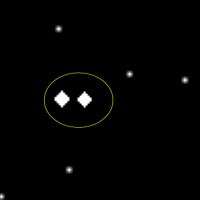NGC 8
 NGC 8's binary stars | |
| Observation data Epoch J2000 Equinox J2000 | |
|---|---|
| Constellation | Pegasus |
| Right ascension | 00h 08m 45.3s[1] |
| Declination | +23° 50′ 20″[1] |
| Other designations | |
NGC 8 is a double star system[1] (K5 and F8) in the constellation Pegasus, discovered on 29 September 1865 by Otto Struve.[2] It is approximately 2.7 arc minutes away from NGC 9.[3] They are most likely unrelated stars, simply an optical binary.
References
- 1 2 3 4 "NASA/IPAC Extragalactic Database". Results for NGC 0008.
- ↑ Steinicke, Wolfgang (2010). Observing and Cataloguing Nebulae and Star Clusters. Cambridge University Press. p. 283. ISBN 9780521192675.
- ↑ "NASA/IPAC Extragalactic Database". Notes for object NGC 0008. Retrieved 2010-05-09.
External links
- NGC 8 on WikiSky: DSS2, SDSS, GALEX, IRAS, Hydrogen α, X-Ray, Astrophoto, Sky Map, Articles and images
Coordinates: ![]() 00h 08m 45.3s, +23° 50′ 20″
00h 08m 45.3s, +23° 50′ 20″
This article is issued from Wikipedia - version of the 11/8/2016. The text is available under the Creative Commons Attribution/Share Alike but additional terms may apply for the media files.